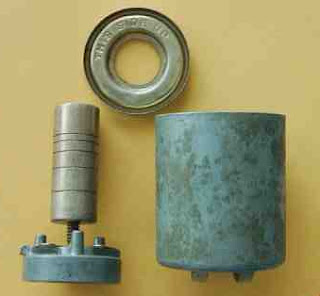Stall Rotor Protection Using Magnetic Overload Relays Oil Dashpot type
A Magnetic Overload relay works by detecting the magnetic field strength generated by the current flowing to the motor. In most cases the relay input is a representation of the current (through C.Ts) flowing into the motor. The Magnetic Overload Relay is built in such a way that the magnetic flux set up by current flowing through the coil drags (pulls) the core upward.
A typical dashpot type magnetic overload relay is shown in
the image below.
Construction.
The relay consists of two main parts which is the trip mechanism at the top and the dashpot at the bottom.
The parts of the relay are further divided into a coil, a plunger (core),
an oil-filled dashpot and switching contacts (trip contacts). The plunger is
attached to a piston (disc). The piston is suspended in an oil filled chamber.
The relay coil is connected in series with the motor supply circuit. During normal operation magnetic flux induced by the coil is not
great enough to cause the plunger lift and move towards the trip pin, however if an overload of sufficient
magnitude and duration occurs, the relay picks up and the increased current
flowing through the coil generates a magnetic field strong enough to pull the plunger upward through the oil. When the
plunger reaches the end of its upward travel, it stops against an insulated
trip pin that operates the contacts on the relay and drops the circuit.
Two factors determine the time delay in this type of relay
1) Size of orifice (bypass hole) on the plunger piston through
which the oil must pass
2) Magnitude of overload current = Strength of magnetic field
generated.
Setting Pickup Current and Time Delay.
The plunger is mounted on a threaded stud and the distance the
plunger travels can be adjusted by threading the plunger up or down. This
action affects the current at which the relay would pick up.
The pick-up currents are shown on the nameplate of the relay and
there are lines on the plunger corresponding to the pick-up current. So, to
adjust the pick-up current is as simple as opening up the dashpot and threading
the plunger(core) up or down until the line of the desired pickup current is in
flush with the top of the dashpot.
Time delay is achieved by the viscosity of the oil in
the dashpot, as the plunger moves upward towards the trip pin, its motion is
retarded by the flow of oil around the plunger and disc attached to the bottom
of the plunger. Time delay could be adjusted by rotating a flap on the disc at
the bottom of the plunger to uncover one or more bypass holes of a greater
diameter thereby allowing the piston to travel upward much more freely if less time
delay is desired.
This relay is preferred for stall-rotor protection because pickup current is not affected by changes in ambient temperature, and it has a faster response time than the thermal overload relay.
We cannot talk about motor stall without talking about Locked Rotor Amps. Locked Rotor amps is the amount of current an electric motor draws when the motor is energized it is also known as Inrush Current.
When the motor is energized, the rotor is at stand still; the rotor is considered locked therefore, it tries to pull an infinite amount of current. Normally, it will be six to seven times of the motor full-load current but as the rotor starts to accelerate to full speed, the current decays until it gets to a steady value.
Once the motor is started, the stall rotor relay would see the in-rush current and pick-up but due to the oil in the dash pot the plunger would travel slowly but before the plunger reaches the end of its travel the motor is expected to have accelerated to full speed and the current is expected to have dropped below the pick-up current of the relay.
The time it takes for the plunger to completely travel through the oil to the trip pin is slightly greater than the time it takes for the motor to accelerate form standstill to full speed.
(i.e) Plunger travel time > Motor starting time
(9secs) > (8secs)
If
for any reason, there is a type of mechanical restriction on the motor, or if a stalling condition exists the current would remain at a high value and the plunger would reach the end of its travel
before the electric motor reaches full acceleration causing the relay to trip.







Comments
Post a Comment